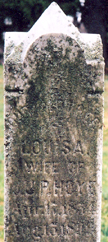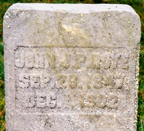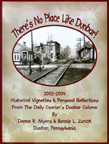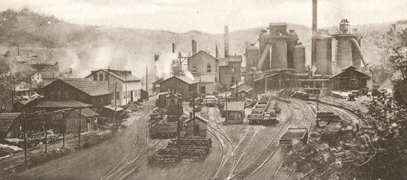
|
Louisa
(Minerd) Hoye |
Louisa (Minerd) Hoye was born on April 17, 1854 in Preston
County, WV, the daughter of Burket and Susan
(Hartzell) Minerd. Much of what is known of her is from the 1942 book, The
Hoyes of Maryland, by Captain Charles E. Hoye.

Franklin Cemetery
In about 1874, when Louisa was 20, she married 27-year-old John Jacob Paul Hoye Sr. (1847-1902), a native of either Maryland or West Virginia, and the son of John "of William" and Ann Elizabeth "Nancy" (Craver) Hoye.
The Hoyes had five known children -- Arona "Ina" B. Hoye, Margaret "Maggie" McClain, John J.P. Hoye Jr., Anna Bunting and William Harlan Hoye. Sadly, the youngest, William, died in 1888 at the tender age of about two months.
John appears to have grown up on his father's 932-acre farm in Garrett County, a tract bearing the name "William and Mary." After his father's death, John thus was entitled to a share of the property with his siblings Samuel C. Hoye, Ellen J. Hoye, Mary A. Hoye, William D. Hoye, Virginia E. Hoye, Ida J. Hoye and Annie E. Hendrickson.
He was named in the Oakland Republican in April 21, 1877 when his rights to two of the lots within the acreage -- Military Lots 1387 and 1389 -- were sold by Sheriff John C. Dunham to William H. Hall. A few years later, the siblings further conveyed their rights to the property, and in a legal advertisement in the Republican, in December 1880, he renounced his interest in the tracts and it appears that William Chisholm purchased it from the heirs.
The family first resided in Oakland, Garrett County, MD, where their first two children were born. Oakland is just a short distance over the county line from Louisa's birthplace. John is known to have joined the Methodist Episcopal Church in Oakland in January 1881 following a "protacted meeting" or revival led by Rev. S.E. Jones, and reported in the Republican's gossip columns.
In 1880, when the federal census was taken, Louisa and her two
young daughters were residing in the home
of her "hopelessly invalid" mother in Oakland. Louisa's occupation was listed as "Washwoman."
John's whereabouts at that time are not known, but he may have been away working.
About that same year, the Hoyes moved "from Oakland to Dunbar," Fayette
County, PA, according to the 1942 book, The Hoyes of Maryland,
authored by Capt. Charles E. Hoye.

Book naming the family
Louisa's sister Mary Cole had relocated earlier to Dunbar, and may have helped persuade the Hoyes to join her there. Dunbar was booming as an industrial center, and was famed as the home of Dunbar Furnace.
In 1900, the Hoye and Cole families lived side by side in the town. Dunbar in the late 1800s was filled with many branches of Minerd-Miner-Minor family descendants -- in fact, after Mary was widowed later in life, she married neighbor and distant cousin Isaac F. Minerd.
After arriving in Dunbar, the last three Hoye children were born.
|
|
|
Dunbar Furnace in full operation, belching smoke |
Sadly, Louisa surrendered to the angel of death in Dunbar on Aug. 15, 1899.
The cause of death was a buildup of fluids in her lungs. A brief
obituary in the Uniontown Genius of Liberty reported that
"Mrs. John J.P. Hoye, aged about 45, died Monday night of dropsy. She
leaves a husband and four children." She was buried at Franklin Cemetery in
Dunbar. Her grave marker, when photographed in the spring of 2003, was darkened
and barely legible.
![]()
Uniontown Genius of Liberty
John outlived his wife by just three years.
Tragically, on Dec. 1,
1902, he
"died from injuries suffered in a railroad accident," said the Hoyes book. According to headline coverage in the Connellsville Weekly Courier:

Connellsville Weekly Courier
Train No. 51 due here from Fairmont at 5:30 in the evening struck and killed
John J.P. Hoye a short distance from Dunbar Monday evening. Hoye was placed
aboard the train and brought to Connellsville. An ambulance met the train here
but Hoye had died in the baggage car between Gibson Junction and the station.
Hoye lived at Dunbar and leaves a wife and family of grown children. One son in
an engineer at the Dunbar furnace and a daughter is lying low with typhoid
fever. He lived on the hill near the Catholic Church.
A number of small boys saw Hoye shortly before he was killed. They
say they made an effort to get him off the track, knowing that No. 51 was about
due. Hoye was struck near the brick yards, one of the most dangerous places in
the county, and a point where more people have been killed than any other. At
the point, however, there is no need to walk on either the Pennsylvania or
Baltimore & Ohio tracks since there is a public road and a fairly good
street on both sides. Hoye's body was taken back to Dunbar Monday evening.
The funeral was held at the family home. John's "horribly
mangled" body was laid to rest beside his wife's remains at Franklin Cemetery. His
grave marker, still visible after more than a century, was photographed by the founder of this website in 2003.

Franklin Cemetery
On April 9, 2003, the tale of John's tragic fate was re-told in an article in the Connellsville Daily Courier.
His story later was republished in the book, There's No Place
Like Dunbar! 2002-2004 - Historical Vignettes and Personal Reflections from The
Daily Courier's Dunbar Column, authored by Donna R. Myers and Bonnie L.
Zurick of the Dunbar (PA) Historical
Society. A thumbnail image of the book is seen
here.

No Place Like Dunbar
[Editor's note -- The Hoyes book was published by Captain Hoye at Sang Run, MD, utilizing the press of the Sincell Printing Company, Oakland, MD. He was the first president of the Garrett County Historical Society and a member of the Maryland Historical Society.]
|
Copyright © 2002-2003, 2005, 2012, 2022 Mark A. Miner |
|
Dunbar Furnace photo courtesy of the Dunbar (PA) Historical Society |
